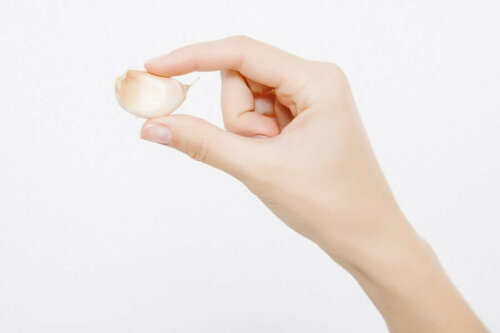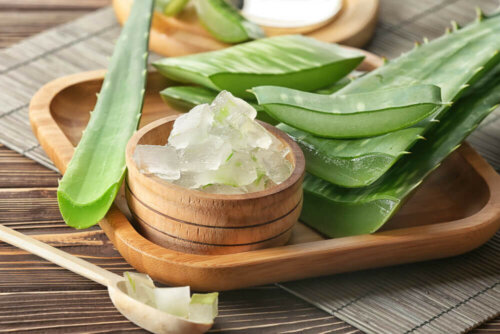Seven Home Remedies to Treat Superficial Mycoses Naturally


Reviewed and approved by the doctor Maricela Jiménez López
Superficial mycoses are fungal skin infections that can manifest anywhere on the body at any age. However, they’re more common on the scalp, genitals, and nails, especially the toenails.
Depending on the type of lesion at the skin site, cutaneous mycosis will differ. Although they’re usually benign fungal pathologies, consultation with a dermatologist shouldn’t be ruled out. Especially if there are several noticeable changes in the skin.
Remedies for superficial mycoses
There are several home remedies to relieve skin mycosis naturally that can be used in addition to the medication prescribed by your physician, if authorized by the professional.
Although their effectiveness isn’t specifically proven by science, they’re used by thousands of people around the world to mitigate the discomfort caused by this skin condition.
1. Tea tree essential oil

Note: to use it, dilute a few drops in plenty of water, as the pure oil could aggravate the problem.
2. Oregano essential oil
Oregano essential oil is believed to have antibiotic and antifungal properties that can help relieve superficial mycosis naturally. Popularly, tonics are prepared with this oil, always diluting it in water.
Read about Tea Tree Oil: The Amazing Oil that Provides Many Benefits
3. Superficial mycoses remedy: ginger
Ginger is a medicinal spice to which several beneficial properties for health are attributed. It stands out for being, mainly, anti-inflammatory and analgesic. However, it’s also said to be antimicrobial, so it’s useful to get rid of certain types of bacteria and fungi.
Supposedly, a homemade ginger tonic can help relieve superficial mycosis naturally.
4. Propolis
Propolis is the substance bees use to keep their hive sterile. For this reason, some people consider it to be one of the best natural antibiotics and a good remedy to relieve superficial mycosis in a natural way. People usually use it the following way:
- Topical: Apply it directly on the affected area. We recommend choosing an alcohol-free propolis product.
- Oral: Take five drops every three hours until the superficial mycoses disappear. As a preventive measure, you can take five drops on an empty stomach every day.
5. Ceylon cinnamon
Cinnamon is a spice that you should definitely have in your medicine cabinet. In fact, its niacin, thiamine, and ascorbic acid content make it a very effective fungicide.
Note: it’s usually recommended to choose Ceylon cinnamon, which is the medicinal variety, to make a home infusion or tonic.
6. Garlic

Garlic is a great treatment against superficial mycoses as it’s a very powerful antibiotic and antifungal agent. You can both apply it topically and eat it raw. If you have a hard time eating it, purchase garlic capsules.
Note: the raw consumption of garlic may cause stomach discomfort for some people. Therefore, we recommend always consuming it in moderation.
7. Superficial mycoses remedy: aloe vera

Finally, aloe vera is another product you must have at home since it can help treat different health conditions. In addition, it’s also a very practical ingredient to add to all kinds of cosmetics and natural products.
It doesn’t just have moisturizing, antioxidant and healing properties, but also antimicrobial properties. Therefore, its application on the area affected by superficial mycosis could be useful.
Always consult your dermatologist
Although many people recommend these remedies, if you have superficial mycosis or any other skin or nail problem, you shouldn’t rule out a visit to your dermatologist.
Remember that the professional will always be able to provide you with the most appropriate treatment for you, as well as the most beneficial recommendations.
All cited sources were thoroughly reviewed by our team to ensure their quality, reliability, currency, and validity. The bibliography of this article was considered reliable and of academic or scientific accuracy.
- Carson CF, Hammer KA, Riley TV. Melaleuca alternifolia (Tea Tree) oil: a review of antimicrobial and other medicinal properties. Clin Microbiol Rev. 2006;19(1):50–62. doi:10.1128/CMR.19.1.50-62.2006
- Garrote A. Micosis cutáneas. Vol. 21. Núm. 8. páginas 82-90 (Septiembre 2002)
- Nazzaro F, Fratianni F, Coppola R, Feo V. Essential Oils and Antifungal Activity. Pharmaceuticals (Basel). 2017;10(4):86. Published 2017 Nov 2. doi:10.3390/ph10040086
- Leyva-López N, Gutiérrez-Grijalva EP, Vazquez-Olivo G, Heredia JB. Essential Oils of Oregano: Biological Activity beyond Their Antimicrobial Properties. Molecules. 2017;22(6):989. Published 2017 Jun 14.
- Hamman, J. H. (2008, August). Composition and applications of Aloe vera leaf gel. Molecules.
-
Bode AM, Dong Z. The Amazing and Mighty Ginger. In: Benzie IFF, Wachtel-Galor S, editors. Herbal Medicine: Biomolecular and Clinical Aspects. 2nd edition. Boca Raton (FL): CRC Press/Taylor & Francis; 2011. Chapter 7.
This text is provided for informational purposes only and does not replace consultation with a professional. If in doubt, consult your specialist.








